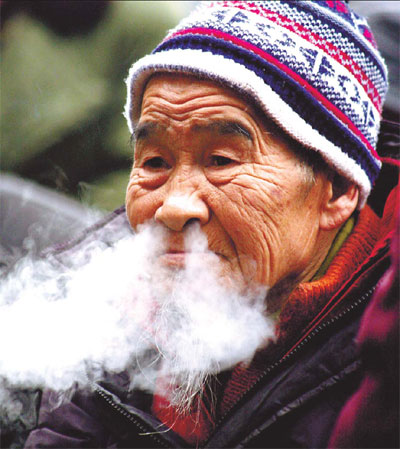Detecting the invisible killer
|
Lung cancer has become the leading cause of death among China's urban population. Qiu Haiying / Asia News Photo |
Lung cancer kills more than 300,000 Chinese people a year and the likelihood of survival is low unless the disease is treated early. Wen Chihua with China Features reports.
Li Xianfeng, a marketing chief at a Jinan-based energy company in Shandong province, didn't feel anything when cancer was developing in the tissues of his lungs and spreading through the rest of his body. He looked good, ate heartily and slept well.
Then, one winter's day in 2004 he started coughing up blood. Li, then 38, suspected something was seriously wrong with his lungs, went to hospital for tests and was diagnosed with late-stage cancer.
"Many patients, like Li, don't have symptoms until the cancer is already in its late stage," says Zhou Qinghua, Li's surgeon and director of the General Hospital of Tianjin Medical University.
Early detection and treatment can make all the difference for those at risk of developing lung cancer, Zhou says.
A national pilot program was launched recently for the early detection and treatment of lung cancer.
"It can help catch the disease when symptoms are not obvious, giving patients more treatment options and bringing about a higher survival rate, with less invasive surgery," says Zhou, the principal investigator of the pilot program, who is also chairman of the advisory board for the early detection and treatment of lung cancer at the Health Ministry.
The goal of the pilot program is to "explore two types of empirical approaches - low-dose spiral computed tomography (CT) scans and liquid-based sputum cytology", says Dr Qiao Youlin, vice-chairman of the advisory board for early detection and treatment of cancers at the Health Ministry.
These two diagnostic methods are widely used and are being evaluated by the US National Cancer Institute at the National Institutes of Health, but, Qiao notes, they have not as yet been recommended by the World Health Organization (WHO) for public screening.
Compared to conventional chest X-rays and sputum smears, the results are more accurate, Zhou Qinghua says.
The mortality rate for lung cancer has increased by 465 percent over the past three decades and has become the country's primary killer among urban populations, and the second leading cause of death in rural populations. The disease takes more than 300,000 Chinese lives annually, according to the Lyon-based WHO International Agency for Research on Cancer.
Zhou notes the five-year-survival rate of lung cancer patients is 80 percent if the disease is detected early.
The figure drops sharply to 13 percent, for patients in China, when their cancer has spread.
"Surgery is the last option for patients with late-stage lung cancer and, the prognosis is not good," Zhou says.
The program is conducted in three locations known for the high incidence and mortality rate of lung cancer, in Tianjin and the cities of Xuanwei and Gejiu, in Yunnan province.
Tianjin, a port city with a population of 11.76 million, has the highest incidence rate of lung cancer among the country's cities. "About 80 out of every 100,000 people are diagnosed as having lung cancer annually, " Zhou says.
About 8,000 people in the city lose their lives to lung cancer each year, Zhou adds.
Zhou and his team will use population-based screening to enroll patients, who will be tested with low-dose spiral CT and liquid-based sputum cytology once a year for three years.
In Tianjin, investigators will screen 1,000 male workers at Dagang Oil Field. The men are aged 50-74 and have smoked 20 cigarettes a day for over 20 years.
Besides genetic factors and air pollution, WHO says tobacco is the most significant risk factor for this lethal disease. That includes secondhand smoke.
Tobacco use and lung cancer are both on the rise in China. China has 350 million smokers, making up one third of the world's smokers, and about 540 million passive smokers.
WHO statistics indicate the occurrence of lung cancer in non-smokers is up to 15 percent of these passive smokers.
Therefore, the program in Xuanwei will target 1,000 smokers, and non-smokers aged 45-69, particularly women who have been exposed for 15 years to coal smoke indoors. Indoor coal smoke emissions contain the carcinogen polycyclic aromatic hydrocarbon. The incidence of cancer among these women is ranked first in the world, says Huang Yunchao, deputy director of Yunnan Cancer Hospital.
Figures from the third national survey on all causes of death in 2006 show the overall incidence of lung cancer here is 91.11 per 100,000, while the number is 21.03 per 100,000 in all of China.
Xuanwei, in the Wumeng Mountain area of Yunnan province, is the main coal producer in Yunnan and people here often use soft coal for heating and cooking.
At the same time, local people have a tradition of making the famed smoked Xuanwei ham. Housewives, predominantly, smoke the salted ham inside their homes, thus producing indoor coal emissions.
Gejiu City is the largest tin producer in the world and here 1,000 underground tin miners aged 50-74 will be screened.
"Due to tin and smelt, lung cancer is an occupational hazard among the miners," Qiao says. "From 1954 to 2002, lung cancer claimed 3,024 lives here. Most of them were tin miners."
Lung cancer is generally untreatable unless its detected at an early stage, before it spreads to the rest of the body, so early detection is crucial.
(China Daily 01/12/2011 page19)



















